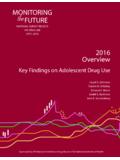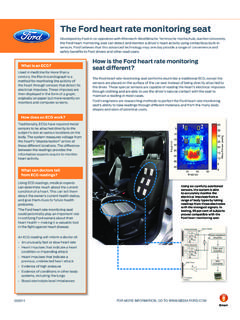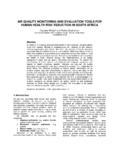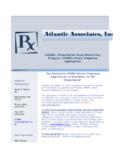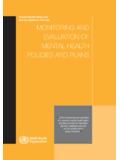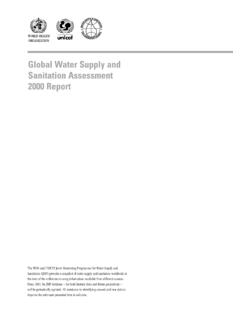Transcription of Monitoring and Evaluating the Food Security and …
1 1 Monitoring and Evaluating the Food Security and nutrition Effects of agricultural Projects Levinson1 and Anna Herforth2 1 Tufts University 2 Cornell University 2 The designations employed and the presentation of material in this publication do not imply the expression of any opinion whatsoever on the part of the Food and Agriculture Organization of the United Nations (FAO) or of the World Health Organization (WHO) concerning the legal status of any country, territory, city or area or of its authorities, or concerning the delimitation of its frontiers or boundaries. Dotted lines on maps represent approximate border lines for which there may not yet be full agreement. The mention of specific companies or products of manufacturers, whether or not these have been patented, does not imply that these are or have been endorsed or recommended by FAO or WHO in preference to others of a similar nature that are not mentioned.
2 Errors and omissions excepted, the names of proprietary products are distinguished by initial capital letters. All reasonable precautions have been taken by FAO and WHO to verify the information contained in this publication. However, the published material is being distributed without warranty of any kind, either expressed or implied. The responsibility for the interpretation and use of the material lies with the reader. In no event shall FAO and WHO be liable for damages arising from its use. The views expressed herein are those of the authors and do not necessarily represent those of FAO or WHO. FAO and WHO, 2013 FAO and WHO encourage the use, reproduction and dissemination of material in this information product. Except where otherwise indicated, material may be copied, downloaded and printed for private study, research and teaching purposes, provided that appropriate acknowledgement of FAO and WHO as the source and copyright holder is given and that FAO and WHO s endorsement of users views, products or services is not implied in any way.
3 All requests for translation and adaptation rights, and for resale and other commercial use rights should be made via or addressed to FAO information products are available on the FAO website ( ) and can be purchased through 3 Abstract The Monitoring and evaluation of agricultural projects for their impact on household food insecurity and nutrition is important given the paucity of data documenting successes and failures in such projects, and because possible adverse effects in such projects need to be identified and addressed rapidly. Recognizing, however, the lack of capacity and/or reluctance of some agriculture project managers and planners to incorporate nutrition considerations in their project planning or their management information systems, a feasible alternative approach is needed one capable of meeting agriculture- nutrition M&E objectives without encumbering project managers. There may be a role for external M&E teams comprised of staff skilled in agriculture- nutrition linkages (Ag2 Nut teams).
4 These teams could identify sensible indicators to measure nutrition -relevant impact based on the type of activities in the program, carry out the key M&E necessary for tracking progress, and feed back to the program management; they also could support nutrition -sensitive program design or adjustment. The teams could carry out M&E for food Security and nutrition at geographically representative sentinel sites, where baseline data are followed by the collection of quantitative and qualitative data at six month intervals. Data collected in these areas plus comparable control sites would include (a) information indicating participation and the extent to which households and individuals within households have been reached/affected by the project , (b) data on household food insecurity levels and on dietary quality, (c) where appropriate, data on young child nutritional status (collected annually), (d) information on women s empowerment (qualitative and quantitative); (e) information which might indicate harm to food Security or nutrition ( increased time constraints, or inadequate protection of natural resources), and (f) data on a subset of data of primary interest to project managers.
5 Ag2 Nut teams would work with local agriculture staff in initial projects to test the approach while developing prototypes, training modules and TA mechanisms. Where Ag2 Nut teams also are sufficiently involved in project design, and where explicit understandings exist that harmful effects will be quickly addressed by project management, such systems have the potential to move this type of nutrition -sensitive intervention forward. In addition, they offer an opportunity to build capacity among program managers to plan for and to measure food Security and nutrition effects of programs. The approach offers a means of assessing the effects of operational nutrition -sensitive agriculture projects that are rolling out in the immediate term, thus enabling learning from substantial investments. It would also enable agriculture projects to understand their impact on food Security and on nutrition , two goals that 4 are often explicitly sought, particularly in the current environment where there is increasing desire to improve impact on nutrition .
6 I. Introduction Although efforts to improve food Security and nutrition through agricultural projects have been attempted for many years, the issue is now receiving high level international policy attention for the first time. The SUN movement has identified the need for nutrition -sensitive development through agricultural investments, UN and bilateral agricultural programs including those supported by USAID s Feed the Future, and Agence Fran aise de D veloppement (AFD) explicitly seek to improve nutrition , dozens of meetings and papers have been put forth by international development institutions and high-level UN bodies, and an Ag2 Nut Community of Practice, with monthly conference calls, emails and a website to update interested persons on new developments has, at the time of writing, over 600 members from around the world. Recent reviews point out that the evidence base for agriculture projects impact on nutrition needs to be strengthened (Masset et al.)
7 2012, Webb Girard et al. 2012). The evidence base needs not only to determine whether agriculture projects affect nutrition overall, but how. For example, past reviews focused on elements of projects that made them more or less likely to have positive nutrition impact; yet all of these reviews indicate the need for stronger methodological designs in future Ag2 Nut evaluations (World Bank 2007, Berti et al. 2004, Leroy and Frongillo 2007, Herforth et al. 2012). Additionally, it will be useful to assess food Security and nutrition impacts not only in those projects that are focused primarily on improving nutrition , but also in more conventional production-oriented projects that may, nonetheless, have been justified partly on the basis of their potential contribution to food Security and nutrition . As an example, earlier literature looking broadly at agricultural commercialization projects found limited impact on child nutritional status, but did not assess more proximal factors such as dietary quality or food Security (von Braun and Kennedy 1994).
8 The Monitoring and evaluation of agricultural projects for their impact on household food insecurity and nutrition is important given the paucity of data documenting successes and failures in such projects, and because possible adverse effects in such projects need to be identified and addressed rapidly (Levinson 2011, Herforth et al. 2012). The idea of nutrition -sensitive agriculture has captured the imagination of many professionals in the nutrition community and a growing number of agriculturalists; it has been the topic of over 50 publications by international development institutions, most of them published in the last five years (FAO, 2013). However, the idea of nutrition -sensitive agriculture has not yet been internalized by agriculture project planners and managers. Explanations for this are not difficult to discern. 5 With a decline in funding for agricultural development in low income countries, agriculture planners are hard pressed to generate adequate resources for their projects.
9 Given internal pressures on these projects to increase the production of particular commodities and to generate increased income for their producers, project managers are, not unexpectedly, reluctant to add additional dimensions to their projects, despite pressure from environmental and women s interests, and now nutrition . With respect to Monitoring and evaluation, agriculture project planners and managers are facing considerable difficulty even with their existing orientation. An important FAO/World Bank analysis (2010) found agriculture project M&E efforts riddled with many of the same problems plaguing development problems more generally: (a) externally imposed obligations, but with findings rarely integrated into operational systems, (b) unmanageable data collection and reporting demands, (c) primary attention to the delivery of goods and services rather than project outcomes, and (d) inadequate institutional capacity.
10 With this panoply of problems, agricultural planners and managers are less than eager to include additional elements in their M&E systems. Yet the agricultural sector is among the most important in its effects on nutrition , and much can be learned from programs currently being funded. Recognizing the existing constraints in agriculture M&E, and the traditionally lower prioritization of nutrition -related issues in agricultural planning, there may be value in examining alternatives to incorporating nutrition indicators into mainline agriculture project management information systems in the short term. II. An Alternative Approach Given the above, the Monitoring and evaluation of the nutrition and food Security dimensions of nutrition -sensitive agriculture projects should seek to accomplish the following: a. Provision of high quality data on the food Security and nutrition effectiveness of nutrition -sensitive agriculture projects, making sure, at the same time, that up-to-date Monitoring data on the delivery of project services (activities and outputs) and on intermediate outcomes (in these projects, progress in generating income, increasing production, expanding diversity) is being collected through the project s management information system; b.










